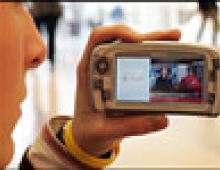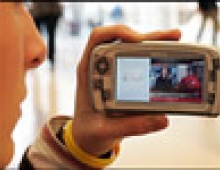
Mobile TV Requires Higher Frequencies
The European telecoms industry is looking for new, higher frequencies to make up for a shortage of airwaves that can be used to enable consumers to watch television on the go.
This is likely to lead to rising costs for mobile handset vendors and possibly also for telecoms operators, which will in turn mean higher prices for consumers, hampering the fledgling mobile TV business before it has started to take off.
The largest players in the handset industry, led by top handset maker Nokia , are pushing for a DVB-H standard using broadcasting spectrum, like traditional television's UHF band, for mobile television. But that will not be available across Europe until analog broadcasts are switched off across the continent around 2012.
Cell phone makers and operators are keen to tap the potentially lucrative market for mobile TV, but so far only a few countries have a dedicated spectrum for a mobile TV network.
Many operators already sell mobile television over their third generation networks, but picture quality and the number of channels are limited. Handset industry executives say they hope the take-up of 3G television will get people interested in watching TV on their handsets.
On Thursday DVB Project said at a news conference at the 3GSM mobile communications trade show it had approved the technical specifications for S-band, opening an available high spectrum across Europe for mobile television broadcasts.
The new DVB-SH would battle with Qualcomm's MediaFLO technology; Ericsson's MBMS, an evolution of 3G technology; and many others.
The DVB-SH standard would use radio frequency above current 3G networks, which would enable use of the existing 3G networks and antennas for receiving mobile TV broadcasts of up to 90 channels, said an official from Alcatel-Lucent , the largest promoter of the standard.
The European Commission, meanwhile, is investigating the possibility of opening part of the L-band for mobile TV broadcasts across Europe. EU Information Society Commissioner Viviane Reding is set to unveil the Commission's next move in a speech at the March CeBIT trade show in Germany.
Building a network for L-band, however, would cost two to three times more than for the UHF band and would raise costs for handset vendors, industry players said.
The largest players in the handset industry, led by top handset maker Nokia , are pushing for a DVB-H standard using broadcasting spectrum, like traditional television's UHF band, for mobile television. But that will not be available across Europe until analog broadcasts are switched off across the continent around 2012.
Cell phone makers and operators are keen to tap the potentially lucrative market for mobile TV, but so far only a few countries have a dedicated spectrum for a mobile TV network.
Many operators already sell mobile television over their third generation networks, but picture quality and the number of channels are limited. Handset industry executives say they hope the take-up of 3G television will get people interested in watching TV on their handsets.
On Thursday DVB Project said at a news conference at the 3GSM mobile communications trade show it had approved the technical specifications for S-band, opening an available high spectrum across Europe for mobile television broadcasts.
The new DVB-SH would battle with Qualcomm's MediaFLO technology; Ericsson's MBMS, an evolution of 3G technology; and many others.
The DVB-SH standard would use radio frequency above current 3G networks, which would enable use of the existing 3G networks and antennas for receiving mobile TV broadcasts of up to 90 channels, said an official from Alcatel-Lucent , the largest promoter of the standard.
The European Commission, meanwhile, is investigating the possibility of opening part of the L-band for mobile TV broadcasts across Europe. EU Information Society Commissioner Viviane Reding is set to unveil the Commission's next move in a speech at the March CeBIT trade show in Germany.
Building a network for L-band, however, would cost two to three times more than for the UHF band and would raise costs for handset vendors, industry players said.















